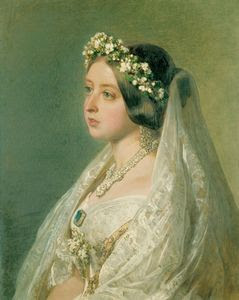 | |
| A portrait of Queen Victoria in her lace wedding dress, painted by Franz Winterhalter seven years after her marriage to Prince Albert. |
On this day, in 1840, Queen Victoria and Prince Albert married at St. James's Palace. So it seems a perfect opportunity to take a closer look at the dress she wore—a dress that influenced the future of bridal gowns.
There's a common misconception that Victoria was the first bride to wear white, when in fact it had been a long-standing tradition for wealthy or noble women. She was, however, the first royal bride to shun the traditional robes for a more common (though still fanciful) style of dress. Marriages, which were primarily secured for reasons other than love, were largely displays of wealth, and the dress—with its rare fabrics and precious jewels—was a potent symbol of the bride’s dowry. The choice of white had little to do with purity (that’s a 20th-century application) but rather the sheer value of white textiles. Before the invention of simple bleaching techniques white was a very hard color to achieve, and extraordinarily difficult to maintain.
But for Queen Victoria, who came to the marriage not merely as a youthful bride but as a head of state, the dress had to reflect more than wealth. It needed to reflect power, and to make a firm political statement. In an era of new technology and the mass-production of goods, Victoria chose a gown of hand-made Honiton lace, giving an immediate and much needed boost to a dying trade. While white did still symbolize wealth, the making of the gown represented her support of British arts, duty and patriotism.
But there were sentimental symbols, too, woven into the queen's wedding regalia. Rather than a tiara, the queen wore a wreath of orange blossoms (for purity) and myrtle (for love). It’s said that a small branch of the myrtle from her bouquet was planted, and that cuttings from it have been used for every royal wedding bouquet since, including that of the Duchess of Cambridge.
 |
| Kate Middleton's bouquet, designed by Shane Connolly, featured myrtle, lily-of-the-valley, sweet William, and hyacinth. |
Queen Victoria was so fond of her wedding dress that she was painted in it many times, and long after 1840. She lamented the fact that photography had not yet been introduced at the time they married, so years later she and Prince Albert recreated the ceremony to capture it in pictures, like the one below.
Victoria made numerous alterations to the dress over the decades, and its original lace skirt no longer exists, but conservators at Kensington Palace in London have been hard at work preparing it for a new permanent exhibition, Victoria Revealed, opening this spring.
 |
| A conservator at work on Victoria's dress. |
 |
| A detail of the lacework on the sleeve. |
 |
| Victoria's silk wedding slippers. |
 |
| A detail of the manufacturer's label. |
To learn more about the upcoming exhibition and other royal wedding objects in the collection of the Historic Royal Palaces, click here.


No comments:
Post a Comment